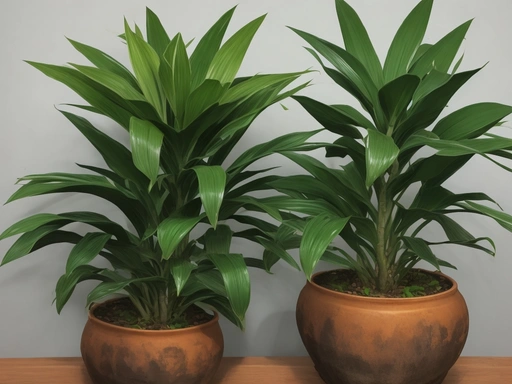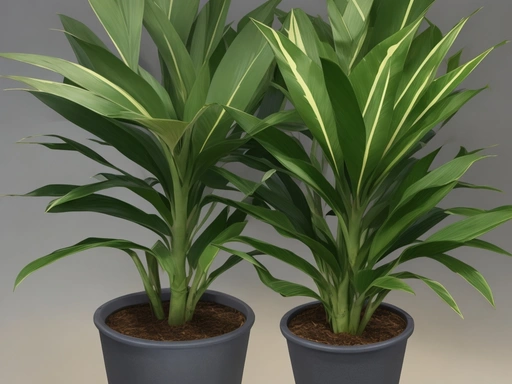Best Dracaena Varieties For Low Light – A Green Oasis
Key Takeaways:
- Dracaena varieties such as Dracaena marginata and Dracaena fragrans are well-suited for low light conditions.
- These plants are resilient and can tolerate lower light levels, making them ideal for indoors or darker corners.
- The Dracaena varieties mentioned are not only low light tolerant but also known for their air-purifying qualities.
- By choosing the right Dracaena variety for low light, you can bring greenery and fresh air into spaces with limited natural light.
Are you a plant lover who’s struggling to find the perfect green companion for your low-light space? Well, look no further! In this article, I’ll be sharing my top picks for the best Dracaena varieties that thrive in low light conditions.
Whether you have a dimly lit office or a cozy corner at home, these plants are sure to add beauty and life to your space.
From the vibrant leaves of the Dracaena reflexa to the elegant stalks of the Dracaena marginata, there’s a variety for everyone. But that’s not all – I’ll also be diving deep into care tips and common issues to ensure your Dracaena stays healthy and happy.
Let’s get started and bring some green magic into your low-light world!
| Dracaena Variety | Light Requirement | Size | Benefits |
| Dracaena Marginata | Low to medium light | Up to 6 feet tall | – Tolerates low light conditions welln- Attractive red-edged leavesn- Air-purifying qualities |
| Dracaena Fragrans (Corn Plant) | Low to medium light | Up to 6 feet tall | – Can tolerate dimly lit areasn- Tropical appearancen- Helps improve indoor air quality |
| Dracaena Janet Craig | Low to medium light | Up to 3 feet tall | – Adapts well to low light conditionsn- Glossy, dark green leavesn- Removes indoor air pollutants |
| Dracaena Reflexa (Song of India) | Low to medium light | Up to 4 feet tall | – Thrives in shade or filtered lightn- Attractive variegated foliagen- Known for its resilience |
Best Dracaena varieties for low light
Looking for the best Dracaena varieties for low light? Check out these top options: Dracaena fragrans (Corn Plant), Dracaena marginata (Dragon Tree), Dracaena reflexa (Song of India), Dracaena surculosa (Gold Dust Dracaena), and Dracaena deremensis (Warneckii).
Dracaena fragrans (Corn Plant)
Dracaena fragrans, also known as the Corn Plant, is a popular choice for low light conditions. It has long, arching leaves with a vibrant green color.
This plant can tolerate lower light levels than many other Dracaena varieties, making it a great option for indoor spaces with limited natural light.
Just make sure to place it near a north or east-facing window to provide it with some indirect sunlight. Overall, the Corn Plant is a low-maintenance and attractive addition to any low light environment.

Dracaena marginata (Dragon Tree)
Dracaena marginata, commonly known as the Dragon Tree, is a popular houseplant that can thrive in low light conditions.
It features long, slender leaves that are typically dark green but can also have a reddish hue along the margins.
While it prefers bright, indirect light, it can tolerate lower light levels, making it a great choice for homes or offices with limited natural light.
Dragon Trees are easy to care for and can tolerate some neglect.
They prefer slightly dry soil, so make sure to let the top inch of soil dry out between waterings.
As for fertilization, a balanced houseplant fertilizer once every two months during the growing season should be sufficient.
Overall, the Dragon Tree is a beautiful and resilient plant that can bring a touch of nature to any low light space.
Dracaena reflexa (Song of India)
Dracaena reflexa, also known as Song of India, is a popular variety of Dracaena that can tolerate low light conditions. It has beautiful, variegated leaves with green and yellow colors.
It is relatively easy to care for and can thrive in indirect or filtered light.
When watering, make sure the soil is evenly moist but not waterlogged. Prune any yellow or brown leaves to maintain its appearance.

Dracaena surculosa (Gold Dust Dracaena)
Dracaena surculosa, also known as Gold Dust Dracaena, is a popular variety of Dracaena that thrives in low light conditions.
Its striking green leaves are speckled with golden-yellow dots, giving it a unique and attractive appearance.
It requires minimal care and can tolerate lower light levels compared to other Dracaena varieties.
Ensure it is placed in a spot where it receives indirect or filtered light, and avoid direct sunlight as it can cause leaf burn.
Water the plant when the top inch of soil is dry, and make sure to provide adequate humidity.
Use well-draining soil and fertilize occasionally to keep your Gold Dust Dracaena happy and healthy.

Dracaena deremensis (Warneckii)
Dracaena deremensis (Warneckii) is a popular variety of Dracaena known for its striking striped leaves. It thrives in low light conditions, making it a perfect choice for indoor spaces with limited sunlight.
The Warneckii is relatively easy to care for, requiring moderate watering and well-draining soil.
Keep an eye out for common issues like yellowing leaves or pests, and you’ll have a beautiful and thriving Dracaena deremensis (Warneckii) in no time.
Care tips for Dracaena in low light
In low light, place your Dracaena near a bright window without direct sun.
Water your Dracaena when the top inch of soil feels dry and maintain moderate humidity levels.
Placement and light requirements
Dracaena plants are versatile and can tolerate low light conditions, making them suitable for placement in various areas of your home or office.
They prefer bright, indirect light but can also tolerate partial shade.
Avoid placing them in direct sunlight, as it can scorch their leaves.
Remember, the lighter the foliage of the Dracaena variety, the more light it typically requires.

Watering and humidity needs
Dracaena plants have moderatelighter the foliage of the Dracaena varietyt’s important to avoid overwatering, as this can lead to root rot.
Allow the top inch of soil to dry out before watering again.
Use room temperature water and ensure good drainage. As for humidity, dracaenas can tolerate average levels, but appreciate the occasional misting to increase humidity.
Soil and fertilization
To thrive in low light conditions, Dracaena requires well-draining soil.
A mix of peat moss, perlite, and sand works well.
Fertilize the plant once every 2-3 months using a balanced liquid fertilizer.
Avoid over-fertilizing, as it can lead to root burn.
Regular soil moisture testing is recommended to ensure optimal growth.
Common issues with Dracaena in low light
Dracaena in low light can experience yellowing or browning leaves, drooping or wilting stems, as well as pests and diseases.
Yellowing or browning leaves
Yellowing or browning leaves in Dracaena can be a sign of several issues. It could be due to overwatering, underwatering, or exposure to direct sunlight.
Check the moisture level of the soil, adjust watering accordingly, and make sure your plant is placed in the right lighting conditions.
Trimming off the affected leaves can also help the plant focus its energy on new growth.
Drooping or wilting stems
Drooping or wilting stems in Dracaena plants can be a sign of overwatering or underwatering. Make sure to check the moisture levels in the soil and adjust your watering accordingly.
Also, ensure that your plant is not exposed to direct sunlight or extreme temperatures.
Consider moving it to a spot with better lighting conditions.
Pests and diseases
Dracaena plants are generally resilient and don’t face many pest or disease issues. However, there are a few common problems to watch out for.
Spider mites can be a nuisance, causing leaves to look speckled or yellow.
Mealybugs can also attack, leaving a cottony residue on the plant. To prevent these pests, regularly inspect your Dracaena and wipe down the leaves with a damp cloth.
Overwatering can lead to root rot, so make sure to let the soil dry out between waterings.
Frequently Asked Questions
Can Dracaena survive in complete darkness?
No, Dracaena cannot survive in complete darkness. They are tropical plants that require at least some indirect or filtered light to thrive.
Complete darkness will cause them to become weak, lose their vibrant colors, and eventually die.
If you want to keep your Dracaena healthy, make sure to provide it with some light.
How often should I water my Dracaena in low light?
In low light, you should water your Dracaena when the top inch of soil feels dry. Stick your finger into the soil to check.
Avoid overwatering, as Dracaenas are sensitive to excessive moisture.
Ensure proper drainage in the pot and use a well-draining soil mix.
Can I propagate Dracaena in low light conditions?
Yes, you can propagate Dracaena in low light conditions.
One method is through stem cuttings.
Simply cut a healthy stem, remove the lower leaves, and place it in a glass of water or moist soil.
Another method is through air layering, where you make a small cut in the stem and wrap it with moist sphagnum moss.
Both methods can result in successful propagation, even in low light.
Final Verdict
If you’re looking for low-light houseplants that are both beautiful and easy to care for, Dracaena varieties are an excellent choice. The Dracaena fragrans, marginata, reflexa, surculosa, and deremensis are known for their ability to thrive in low-light conditions.
By following the care tips mentioned, such as finding the right placement, providing adequate water and humidity, and using suitable soil and fertilization, you can ensure the health and vitality of your Dracaena plants.
Should any issues arise, such as yellowing leaves or drooping stems, there are solutions available to address them. With proper care, these versatile and low-maintenance plants can enhance the aesthetics of any dimly lit space.
So why wait?
Bring some greenery into your home with these remarkable Dracaena varieties.







